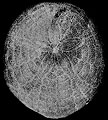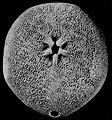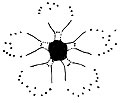Faujasia is very similar to Pygidiolampas. Both genera have broad, equal petals that are almost closed distally, subcircular tests, very similar floscelles, and apical systems where the gonopores are located outside the genital plates in the interambulacra. Kier (1962) reports that the apical disc in Faujasia is monobasal and in Pygidiolampas tetrabasal. In his photos of the holotype this is unclear, and should be treated with a degree of skepticism, particularly as Kier (1962) fails to mention that the gonopores are located outside the genital plates in the holotype of Pygidiolampas. We have therefore tentatively treated Pygidiolampas as a subjective junior synonym of Faujasia.
Kier (1962) erected a new genus (Domechinus) for species of Faujasia whose gonopores were clearly associated with plates of the apical system. Such a difference is important, but given the otherwise great similarity in test structure and shape, Kier\'s genus is treated here as a subgenus of Faujasia. Therefore species of Faujasia that have their genital pores located outside the genital plates in the interambulacra are referred to Faujasia, while species that the gonopores in the genital plates are referred to Domechinus.
P. M. Kier. 1962. Revision of the cassiduloid echinoids. Smithsonian Miscellaneous Collections, 144 (3) 262 pp.
d'Orbigny, A. 1854-60. Paléontologie Française. Terrains Crétacés. Tome 6. Echinodermes, Échinoides irréguliers. 596 pp, pls 801-1006. G. Masson, Paris. 1-32 (July 1854); 33-64 (Oct. 1854); 65-96 (Nov. 1854); 97-128 (Jan. 1855); 129-192 (Mar. 1855); 193-208 (May 1855); 209-224 (Aug. 1855); 225-272 (Nov. 1855); 273-320 (Oct. 1856) pp. 273-352 (Oct. 1856), pp. 353-384 (1857), pp. 385-400 (1858), pp. 401-432 (1858), pp. 433-596 (1860).



